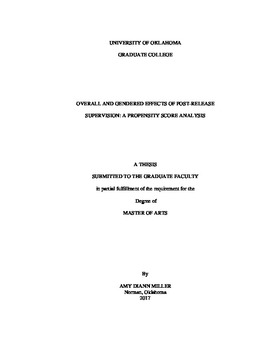| dc.description.abstract | The number of people in the correctional population has skyrocketed in recent decades, with the majority being supervised within the community after release. The female correctional population, which has historically been small, has also increased in number. The purpose of this paper is to investigate the overall and gendered effects of post-release supervision. Using propensity score matching, I discover that post-release supervision is associated with a 4% to 4.5% reduction in recidivism, measured by both rearrest and reconviction. Men echo the overall trend while the numbers for women are much smaller and nonsignificant. Indeed, among supervised females we anticipate no significant reduction in recidivism measured by rearrest. With the amount of time, energy, and money spent on supervising offenders after release, future studies should further this research by conducting a cost benefit analysis and investigating the most effective types of supervision in reducing recidivism. | en_US |
